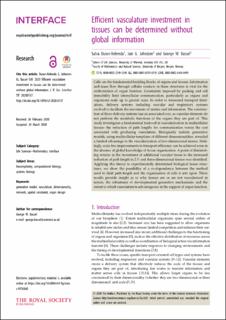| dc.contributor.author | Johnston, Iain George | |
| dc.contributor.author | Bassel, George | |
| dc.date.accessioned | 2021-08-06T09:35:32Z | |
| dc.date.available | 2021-08-06T09:35:32Z | |
| dc.date.created | 2021-03-16T09:12:55Z | |
| dc.date.issued | 2020 | |
| dc.identifier.issn | 1742-5689 | |
| dc.identifier.uri | https://hdl.handle.net/11250/2766761 | |
| dc.description.abstract | Cells are the fundamental building blocks of organs and tissues. Information and mass flow through cellular contacts in these structures is vital for the orchestration of organ function. Constraints imposed by packing and cell immobility limit intercellular communication, particularly as organs and organisms scale up to greater sizes. In order to transcend transport limitations, delivery systems including vascular and respiratory systems evolved to facilitate the movement of matter and information. The construction of these delivery systems has an associated cost, as vascular elements do not perform the metabolic functions of the organs they are part of. This study investigates a fundamental trade-off in vascularization in multicellular tissues: the reduction of path lengths for communication versus the cost associated with producing vasculature. Biologically realistic generative models, using multicellular templates of different dimensionalities, revealed a limited advantage to the vascularization of two-dimensional tissues. Strikingly, scale-free improvements in transport efficiency can be achieved even in the absence of global knowledge of tissue organization. A point of diminishing returns in the investment of additional vascular tissue to the increased reduction of path length in 2.5- and three-dimensional tissues was identified. Applying this theory to experimentally determined biological tissue structures, we show the possibility of a co-dependency between the method used to limit path length and the organization of cells it acts upon. These results provide insight as to why tissues are or are not vascularized in nature, the robustness of developmental generative mechanisms and the extent to which vasculature is advantageous in the support of organ function. | en_US |
| dc.language.iso | eng | en_US |
| dc.publisher | The Royal Society Publishing | en_US |
| dc.rights | Navngivelse 4.0 Internasjonal | * |
| dc.rights.uri | http://creativecommons.org/licenses/by/4.0/deed.no | * |
| dc.title | Efficient vasculature investment in tissues can be determined without global information | en_US |
| dc.type | Journal article | en_US |
| dc.type | Peer reviewed | en_US |
| dc.description.version | publishedVersion | en_US |
| dc.rights.holder | Copyright 2020 The Authors | en_US |
| dc.source.articlenumber | 20200137 | en_US |
| cristin.ispublished | true | |
| cristin.fulltext | original | |
| cristin.qualitycode | 1 | |
| dc.identifier.doi | 10.1098/rsif.2020.0137 | |
| dc.identifier.cristin | 1898231 | |
| dc.source.journal | Journal of the Royal Society Interface | en_US |
| dc.identifier.citation | Journal of the Royal Society Interface. 2020, 17(165), 20200137 | en_US |
| dc.source.volume | 17 | en_US |
| dc.source.issue | 165 | en_US |

